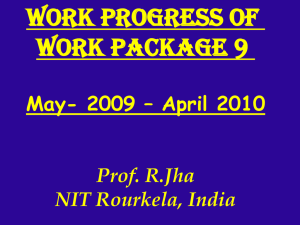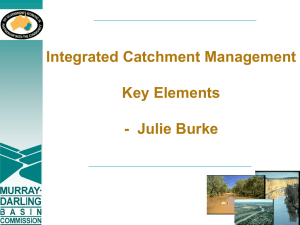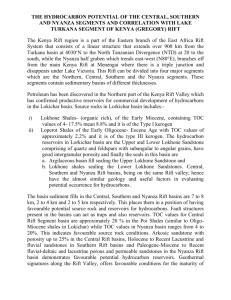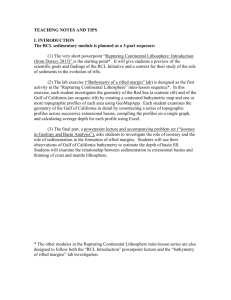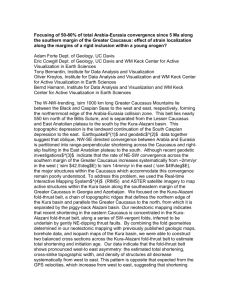AB_GSA14_NRtect_ppt_v4 - Geological Society of America
advertisement
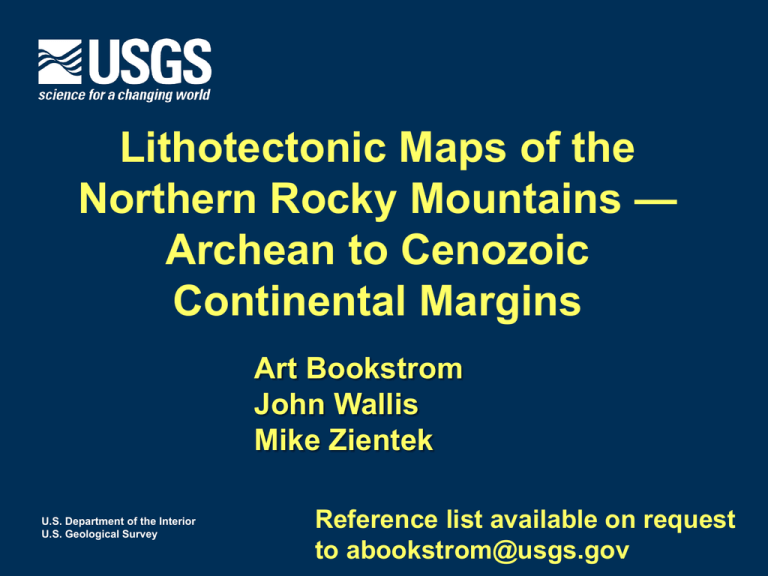
Lithotectonic Maps of the Northern Rocky Mountains — Archean to Cenozoic Continental Margins Art Bookstrom John Wallis Mike Zientek U.S. Department of the Interior U.S. Geological Survey Reference list available on request to abookstrom@usgs.gov Lithotectonic Map, Northern Rocky Mtns Kalispell Spokane Bozeman Boise • 44 geologic maps, 1:100k to 1:250k • Zientek et al. (2005) spatial database USGS OF-2005-1235 • Lithotectonic unit — rocks formed in a shared tectonic setting during a shared time interval • A series of timeslice lithotectonic maps follows PO >2.6-1.5 S Medicine Hat K 3.3-2.6 Selway 2.4-1.6 lue Mtns .3-0.15 B Basementmap underlay S/W BZ WY 3.5-2.7 Frm Grouse Cr. < 2.5 >2.5 WY • MT(Sims et al. ‘04) ID (Sims et al. ‘05) • Terranes & ages (Ga) from Foster et al. ‘06 • Wyoming, Medicine Hat, and Grouse Cr. Blocks (W) • Selway and Farmington terranes (X) • Pend Oreille terrane (W-Y) • Blue Mtns (P-J) NW part of Wyoming craton — 1 of ~35 known Archean cont. nucleii 46N 25 km 44N 112W Archean (W) - metased. rocks (~3.5-3.4) - felsic metavolc. gneiss (~3.5-3.3) – orthoamphibolite (~3.2) – Tn-Trnd-Gd (3.0-2.8), Gd (~2.8) • Wsic – Stillwater complex (2.7 Ma, plume- or rift-related – granite (~2.6?) Crust ~50 km thick, with mafic lower crust, upper meta- sedimentary & volcanic strata, TT and G plutons, & the Stillwater layered intrusion Paleoprot (X) convergence Subduction zone 30 km ID Big Sky orogen was active during assembly of supercont. Nuna (Columbia). X crust (1.9-1.7 Ga) between Wmh and Wwy blocks (~1.8 Ga) implies subduction to NW? (Vogl et al., ‘04) ages metam. reset from W to X (~ 1.6) (1.9-1.6 Ga) active as seaway closed • X island arc thrust over Wyo blk @1.6 (Harms et al. ‘04) Ydt Mesoproterozoic Belt-Purcell basin • Rift Stage — Y1 Yim Y2 Y3 ~15 km in 20 m.y. ~1.47-1.45 Ga • Sag stage —Y4 Yvm Y5 • ~5 km in 200 m.y., (1.45-1.25 Ga) Lemhi sub-basin • Rift to sag — Y4L Yg Ygb ~15 km in 50 m.y., (1.45 to ~ 1.37 Ga) 40 km ~1.15 West half of rifted Belt basin may be in Siberia. Detrital zircons (1.6-1.5 Ga) in Y1-Y3 may be from Australia (Sears ‘07). 0 km DeerTrail basin 0 km 2.2 km Lemhi subbasin 12 km Ma 1070 Ma 1270 Ma 1390 Ma 1454 Ma Belt basin Sedimentaccumulation curve for the Belt basin (from Sears, 2007), and also for the Lemhi subbasin and the Deer Trail basin (added here) Belt-Sediment Source Areas (Ross and Villeneuve ‘03) Belt detrital zircon populations match ages of rocks in N.American sources to the east and south, but also require a western non-N. American source. N.America-Siberia-Australia at ~1.5 Ga (Sears ’07) This reconstruction puts the Belt basin adjacent to the Udzha trough in the Siberian craton, which is adjacent to the NE Australian craton (to the SE). These 3 cratons are part of Nuna (a supercontinent from ~ 1.5-1.0 Ga). Reconstruction constrained by possible sources for detrital zircons), correlation of orogenic belts, and apparent polar wander paths, showing nearly coincident poles at ~1.5 Ga. Laurentia, Australia & Antarctica in Rodinia, 1.6-0.6 Ga (Karlstrom et al. 1999) The N. America-Siberia-Australia model may be better for Nuna and the Belt basin (~1.5-1.3 Ga), but the LaurentiaAustralia model may be better for Rodinia and the Windermere rift. Supercontinent Cycle (after Bradley, 2011) Data gap Ages of northern Rocky Mtn orogens and rifts generally fit the global supercontinent cycle. Neoproterozoic to Triassic inner miogeocline outer miogeocline • ZOr – Windermere upper crustal rift • ZOi – within-plate intrusions • Sr(i) ~ 0.706 - rifted continental basement • COk - Kootenay miogeo. • ODce - Covada eugeo. • Dm – Milligen basin (blk sh) • DMc – Copper basin (delta w/ basal Antler-arc cgl) • Mc – Carbonate banks • PPNw – Wood R. delta • Pp – Phosphoria epicontinental basin • TRc – Continental redbeds Rifted continental margin is overlain by a miogeoclinal wedge that thickens toward the paleo-Pacific Ocean. Permian to Jurassic accreted island arcs next suture 50km • PJq – Quesnellia islandarc • PJb – Blue Mountains island-arc complex • Westward subduction beneath oceanic island arcs stopped during collisional accretion, and • Eastward subduction began outboard from and beneath the augmented continental margin. Blue Mtns accreted island-arc terranes • Baker (PTRb) • Wallowa-SevenDevils (PTRw) • Martin Bidge ls (TRls) Olds Ferry (Trof) • Riggins Gp. (PJr) • Igneous intrusions (Pji) • Jizee (Jiz) • Metam & Ig rx (Jkmi) rx • West-Idaho suture zone ( ~135-74 Ma 25 km Blue Mtns island-arcs probably formed in a tectonic setting similar that of the Philippine islands. TRJi Cretaceous retro-arc foreland basin(rfb) continental arc fold-thrust belt(KT) accreted terranes foldpbb thrust belt(K) 50 km • TRJi ~205-162 Ma • Kai – Alk int ≤ 115 • Kgk – Kaniksu ~107-67 • Kga - Atlanta~90-67 rfb • Kgb - Boulder ~79-66 • KTgb – Bitterroot ~66-54 • KTai - Back-arc hi-K ig rx (≤ 75) Plate convergence, collisional accretion and NE subduction drove crustal thickening, arc-to-backarc magmatism, NE thrusting, and foreland subsidence. Eocene eoTmc – metamorphic core complexes • eoTv – Eocene volcanics (early andesite & later rhyodacite) • eoTi – Eocene intrusions (monzodiorite and monzogranite porphyries) 50 km • eoTb – extensional eoTmc fault-bounded basins Bimodal magmatism and extensional tectonism and may have occurred in response to slab-window over-ride, less convergence & steeper subduction. Neogene features • • • CRB - Columbia R. basalt (17-6 Ma) JD – Joseph dike swarm CNR – Central Nevada rift & basalt (17-14) CRB JD - Snake River Plain, basalt, seds (< 3) CNR Plume-related volcanism, doming & collapse. Uplift of overthick crust, widely distributed extensional faulting.


![Georgina Basin Factsheet [DOCX 1.4mb]](http://s3.studylib.net/store/data/006607361_1-8840af865700fceb4b28253415797ba7-300x300.png)



